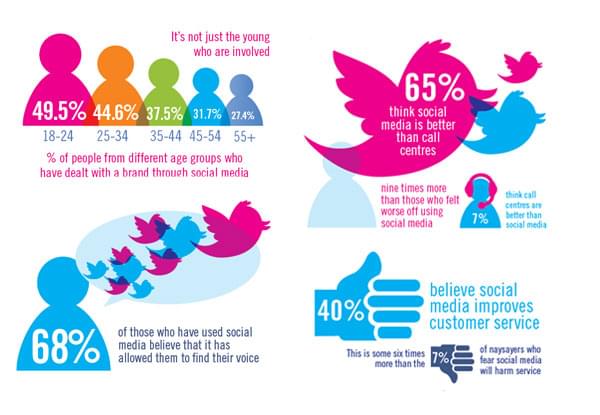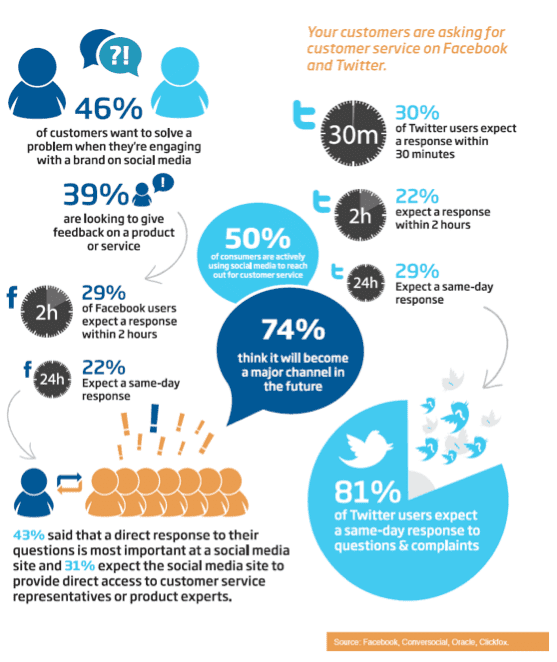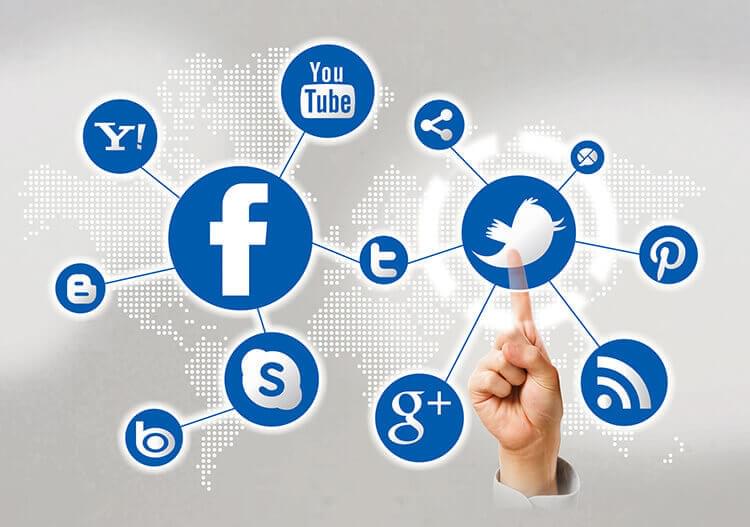Customer service has come a long way since the days of call centers equipped solely with interactive voice response.
Since the 1980s, customer service centers have incorporated software to provide quicker and more accurate support. It began with database management systems storing customer names and purchase information. It continued with the evolution of the service desk providing tech support to office workers, computer telephony integration, email and instant messaging, cloud computing and software-as-a-service CRMs into online helpdesks.
An essential feature of modern helpdesks is the unified inbox -- the single interface through which service agents can respond to tickets conveyed over multiple channels. This has become conventional. The more advanced helpdesks also integrate social channels, which rely on the same technologies as social CRM, but whose features are oriented towards analyzing and proactively responding to customer sentiment.

Social customer service is how the best helpdesks, and the best customer service departments, separate themselves from the rest. But even the best helpdesk is only as good as the agents using it, and the same goes for social customer service. So with that in mind, here are the dos and don’ts of social customer service for your agents’ and your business’ benefit.
What to Do
1. Build a Social Media Presence. This seems self-evident, but it’s more than having an account or even one dedicated to customer service. Customer engagement on social networks entails interacting with customers the way they interact with each other. The democratizing power of the internet gives everyone a voice, and cultivates its own subculture and lingo: the better your brand is able to adopt a style and personality that resonates with your core values and customer base, and train agents to communicate through this brand voice, the more understanding your customers will be during a potential dust-up… at least on social media.
2. Reinforce Your Brand Message. This means training your service staff to communicate using a vocabulary and mindset consistent with your brand voice and values and tailored to the social network. Build a range of canned responses that service agents can deploy for common issues to promote consistency in ticket response, speed up response time and free up agents’ mental bandwidth so they can get creative for the more intractable cases. Do whatever it takes to ensure agents have a baseline of familiarity with every social network tied into your helpdesk.
3. Monitor Your Pages and Mentions. Of course you’ll want staff to stay on top of your own pages -- it’s the social media equivalent of tending to your own yard. Your outward-facing social pages will obviously be public, and allowing customers to see a long string of unanswered support requests, spam or abusive messages -- the latter should be removed promptly -- will negatively impact their impression of your company’s customer service. If you feel your helpdesk’s social capabilities aren’t enough, you might turn to a social monitoring service to track your brand mentions alongside polarizing keywords -- a basic form of sentiment analysis that allows you to reach out to customers even if they haven’t engaged you directly.
4. Rapid Response is Key. We’ve been living in the age of instant messaging for awhile now, and your customers are accustomed to receiving prompt replies. Speed matters. While the customer service issue itself doesn’t need to be rushed, the first reply acknowledging the customer should at least be within the day. A few hours or less is preferable. Meanwhile, while social media communication feels inherently casual, and the support request may come across that way, too, it’s important agents convey the impression that they’re taking the matter seriously. Move quickly, stay professional, gauge the customer’s emotional state, and treat the case as you would others through any other channel.
5. Create a Friendly, Accessible Tone. It’s a much different era than when a corporate-sounding phone voice was the customer service ideal. Today’s customers strongly prefer a more human, authentic brand voice and want to feel like they’re talking to a person who understands them. This is as much part of the cultural zeitgeist as it is the natural frustration of interacting with automated systems that force us to go through lists of options and identity confirmation before matching us with an agent who makes you do it all over again. Convey the sense you value the customers’ time and mood, and they’ll be more forgiving of whatever issue caused them to contact you in the first place.
6. Every Problem is an Opportunity. Instill this philosophy into your service team and it will pay off. Taking each customer service ticket as a chance to turn an unhappy customer into a potential brand evangelist is too good of an opportunity to pass up. Wowing customers with a ticket resolution that exceeds their expectations promotes positive brand mentions and influences their peers’ impression of your company. Customer satisfaction surveys enable helpdesk admins to gain insight on how effectively their agents are engaging the unhappy customers, and whether the customers are walking away with their problem solved.
7. Steer the Conversation Away from Social. Social networks are great platforms for building a brand identity, generating leads, and canvassing customer sentiment, but once you’ve pinned down a specific service case, you should bring that customer into a direct message -- either on the social network or through another channel. While it’ll be mostly the same to your agent, who’s working through a unified inbox in a helpdesk, it’s important to give the conversation some privacy. This allows you to free up space on your social profile and give your agents flexibility to deal with tickets on a case-by-case basis outside of the public eye.
8. Build Self-Service Resources. Your customer service presence benefits from a library of self-service articles available in an online knowledge base. These articles provide how-to guides, FAQs, video tutorials, and so on. Not only can these resources allow enterprising customers to help themselves, which alleviates pressure on your helpdesk agents, but your agents can also link to this content when assisting customers with common problems. This allows service agents to reduce the amount of time between ticket opening and a helpful response.
9. Build an Internal Knowledge Base. Certain problems can’t be solved by linking the customer to a self-service resource, or the customer simply requires more attention from the agent. Providing helpdesk agents with an internal library of service guides that help agents walk customers through steps to resolve their problem will further make your team’s work easier. This way, service agents don’t themselves need to be experts on every aspect of your products or services -- they be effective, sympathetic communicators who are familiar with the products, but more importantly, who know which resources and which people to call upon and when.
10. Drive Shareable, Helpful Content. Social marketing and social customer service can overlap. In a sense, this kind of content that promotes smart use of your products/services is like the extraverted version of the how-to articles available in your knowledge base. You want it to be brief, compelling, informative and, importantly, shareable. As with medicine, an ounce of prevention is worth a pound of cure. You won’t know whose problems you solve, but a cultivated image of customer engagement can attract customers to come to you directly instead of leaving you to detect a viral complaint.

What NOT to Do!
1. Don’t Spam Your Customers. You want to share engaging content, but you don’t want to fill up your customers’ news feeds with every last thought. This may not apply to businesses that have a dedicated customer service social profile, but it’s relevant to any company with a social profile in general -- don’t relentlessly post ads, promotions, reminders, or even success stories. You want your customers to have a breather now and then. Also, diversify the type of content you share. An experienced content strategist can help you achieve this goal, while the right social media coordinator can help you implement this strategy.
2. Don’t Be Too Casual. As mentioned, social networks are inherently casual -- people and corporations can interact on a one-to-one basis -- but customers still expect you to fulfill your role seriously. It will undermine your company’s credibility if your agents are using shorthand, excessive emojis, unprofessional slang, etc. Of course, this depends a lot on the image you cultivate with your target customers as well as each individual customer. Especially for service agents, the number one priority is resolving the problem, with the number two priority forging an empathetic bond with the unhappy customer. Speaking their language, literally and figuratively, ties into priority number two, but it should never distract from number one or sacrifice the credibility of your professional and competent image.
Incorporating a professional headshot in your agents' profiles can enhance the perception of professionalism and credibility.3. Don’t Get Repetitive. Don’t Get Repetitive. (Heh.) This is almost as bad as visitors coming to your public profile and seeing a field of untended complaints. A series of complaints addressed with the same exact reply tells customers your response to their problems will be lackluster. Nobody likes that. Even if your first reply is an acknowledgement, try to change the wording, adjust the tone, add some personalization. Is it more effort? Yes. Do customers appreciate the effort? Also yes. In fact, encourage your service agents to modify canned responses slightly for each ticket. This obligates at least some level of engagement, which makes all the difference for a worried customer.
4. Don’t Get Emotional. Agents are people, too, and the customer isn’t always right. In fact, sometimes the customer is a downright jerk. That said, the agent isn’t representing themselves, they’re also representing your brand, and you may need to remind them of the importance of keeping their cool. A good modus operandi is -- if it bothers you, take a step back, breathe, and maybe ask for a colleague for their thoughts. An irate customer, whether right or wrong, can take a screenshot of an unprofessional exchange and it’ll look terrible for you. Your agents might be fuming on their side of the screen, but they must still address the customer’s complaint within your company’s policies, whether the complaint is resolved or denied (in which case, the agent can enjoy some shadenfreude).
5. Don’t Let It Stay Public. It’s best not to sort out customer service issues in full view of the public. Once the complaint is made and the agent responds (or even in the agent’s first response), request the customer continue the conversation in a direct message. This prevents other customers from seeing the end result -- which might misinform their own expectations -- but also because some customers’ circumstances (and value to your company) might warrant different treatment. Customer service guidelines aren’t hard and fast rules, and your agents need the flexibility to respond to each situation in kind without being bound to the precedent of an unrelated case.
Social customer service brings its own potential pitfalls, but the right training and temperament can bring nearly any customer service issue under control. The internet is rife with stories of social customer service gone awry, but between common social etiquette, an understanding of social networks and your customers, the right helpdesk tools and the right team, there really aren’t any service issues that you can’t handle, let alone ones that would spiral out of control.
Need an effective helpdesk? Compare solutions using provider overviews and user reviews on our free guide to helpdesk ticketing software.



